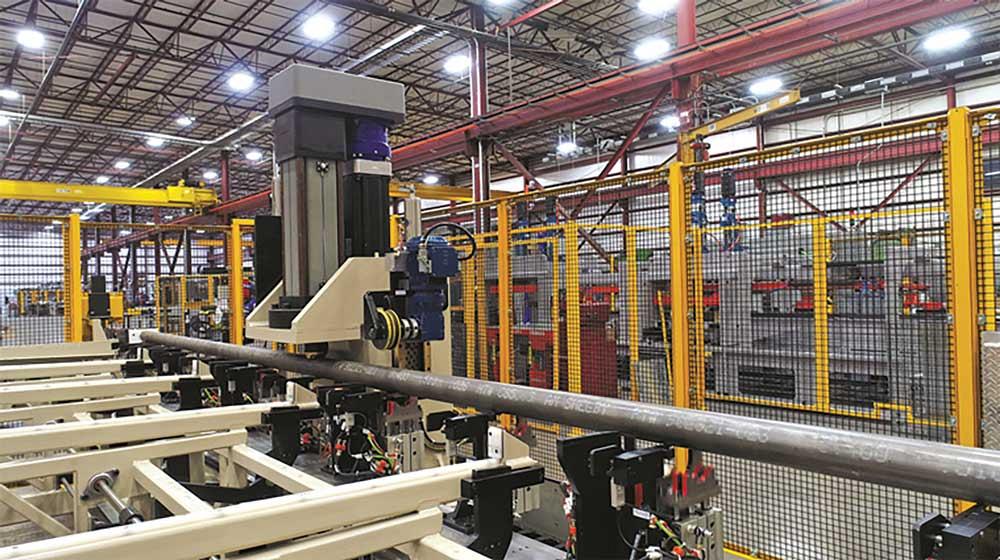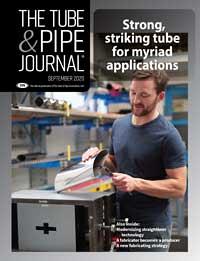- FMA
- The Fabricator
- FABTECH
- Canadian Metalworking
Categories
- Additive Manufacturing
- Aluminum Welding
- Arc Welding
- Assembly and Joining
- Automation and Robotics
- Bending and Forming
- Consumables
- Cutting and Weld Prep
- Electric Vehicles
- En Español
- Finishing
- Hydroforming
- Laser Cutting
- Laser Welding
- Machining
- Manufacturing Software
- Materials Handling
- Metals/Materials
- Oxyfuel Cutting
- Plasma Cutting
- Power Tools
- Punching and Other Holemaking
- Roll Forming
- Safety
- Sawing
- Shearing
- Shop Management
- Testing and Measuring
- Tube and Pipe Fabrication
- Tube and Pipe Production
- Waterjet Cutting
Industry Directory
Webcasts
Podcasts
FAB 40
Advertise
Subscribe
Account Login
Search
Servomotors, AI assist in efficient straightening for tube, pipe, bar
Latest technologies bring latest capabilities to tube, pipe, bar markets
- By Eric Lundin
- September 22, 2020
- Article
- Tube and Pipe Fabrication

Press-type straighteners for tube, pipe, and bar are extremely effective, but conventional machines are labor-intensive, relying on skilled operators. Effective straightening relies on a certain amount of savvy about steel to understand how hot- and cold-working processes can affect a workpiece and make straightening a challenge. Image provided by Coldwater Machine Co.
Although the characteristics of welded tube and pipe are much more uniform now than in the early days of production, they still vary. Depending on the processing steps used to turn a length of raw stock into an intermediate or finished component, straightness can be one of the most critical characteristics. To help bring tube, pipe, and bar into line, producers often use straightening processes before shipping orders. Many fabricators and machine shops go further, using subsequent straightening to achieve even tighter tolerances and reduce the variance to an acceptable amount.
The acceptable amount is the key metric, and it varies by application. A length of pipe for making an automotive hydraulic line doesn’t need to be perfectly straight; it’s probably going to get bent anyway. A hydraulic cylinder, though, is a completely different animal that needs superb straightness to prevent leaks. The same goes for anything that rotates, such as a conveyor roller or a ball screw.
Many tubes and pipes produced for precision applications lack sufficient straightness for finishing operations like machining or centerless grinding. This poses a problem for manufacturers that rely on manually intensive straightening operations. Compounding this challenge is the shortage of skilled labor for these operations, as well as a lack of process repeatability. This can lead to quality problems downstream where vibrations during grinding can cause inconsistent quality or damage to grinding wheels, further adding to costs.
How Straight is Straight Enough?
The cutting, forming, and fabricating processes commonly used to make tubular components might tolerate some camber, but a machine-loading process might not. As automated machines run faster, automated loaders have to keep up, so the straightness variance must be kept to a minimum to prevent misfeeds and jams.
To improve the straightness of tubular products, fabricators and machine shops rely on press-type straighteners. After taking a series of measurements along the length of the tube, pipe, or bar, the operator then applies some skill and some intuition in using the press to make a series of corrections along the length of the workpiece.
“A key problem concerns an operator applying the pressing force in the wrong location,” said Andrew Vickery, a project manager at Coldwater Machine Co., a Lincoln Electric company, in Coldwater, Ohio. “It’s not applied at the peak, but just where the bend starts to form, where it departs from the straight section.” Even when using the press in the right location, the process is full of difficulties. The operator has to push the material past its elastic limit and account for springback. If an initial pressing doesn’t do the trick, he has to account for work hardening in making a second attempt.
Straightening can become trickier still.
“In many cases, the complete manufacturing process for a component consists of straightening, centerless grinding, threading, and another straightening,” said Coldwater’s Vice President of Marketing and Sales Dan Barry. The first three processes impart a bending force once and heat twice. The mechanical and thermal stresses change the metal’s characteristics, reducing the predictability of the second threading operation.
New Strategy for an Old Problem
Coldwater engineers recently revisited the straightener concept and developed a system that uses two technologies, servomotors and artificial intelligence (AI), that have become more affordable in recent years. Servomotors provide high degrees of positioning accuracy, while AI reinforces the capabilities of conventional software by enabling machines to learn.
After a worker loads bundles of tube or bar onto a staging deck, the system takes over, feeding one item at a time into the straightener. The system rotates the workpiece 360 degrees as sensors measure the item at several points along its length to build a profile. This data is sent to the programmable logic controller, where it is compared to the straightness specification to determine where it needs to be corrected.
A servo press, mounted to a servo-controlled rail, moves to the first position determined by the sensors and imparts enough bending force to bring it into tolerance. It moves to the next position, performs the needed bending action, and continues this process until it achieves the straightness requirement. As a final check, it rotates the tube again to collect new data to confirm that the workpiece is within specification. Depending on the user’s process, bars or tubes then are transferred automatically or manually to the next operation.
“Each unique workpiece is identified by a stock-keeping unit (SKU) or some similar identifier, which is the key to the AI’s capability,” said Vickery. “The first time the operator enters an SKU, the system creates a record and stores that SKU’s characteristics. Even though steel characteristics vary by heat and tube, pipe, and bar characteristics vary by alloy, diameter, wall thickness, and manufacturing lot, the system uses each SKU’s data as a reference point. When it sees that SKU again, it has a starting point.”
While it’s difficult to pin down precise cycle times in a process that is bound to vary, Vickery estimates that an initial straightening is likely to take up to 10 or 15 minutes, but a repeat SKU takes much less time, in some cases about five minutes. The system achieves a straightness tolerance within 0.030 in. over a length of 25 ft., he said.
While taking measurements and making corrections about every 6 in. along the workpiece’s length is common, according to Barry, the system can be programmed for more correction points, trading a little more time for a little more accuracy.
About the Author

Eric Lundin
2135 Point Blvd
Elgin, IL 60123
815-227-8262
Eric Lundin worked on The Tube & Pipe Journal from 2000 to 2022.
About the Publication
Related Companies
subscribe now

The Tube and Pipe Journal became the first magazine dedicated to serving the metal tube and pipe industry in 1990. Today, it remains the only North American publication devoted to this industry, and it has become the most trusted source of information for tube and pipe professionals.
start your free subscription- Stay connected from anywhere

Easily access valuable industry resources now with full access to the digital edition of The Fabricator.

Easily access valuable industry resources now with full access to the digital edition of The Welder.

Easily access valuable industry resources now with full access to the digital edition of The Tube and Pipe Journal.
- Podcasting
- Podcast:
- The Fabricator Podcast
- Published:
- 04/16/2024
- Running Time:
- 63:29
In this episode of The Fabricator Podcast, Caleb Chamberlain, co-founder and CEO of OSH Cut, discusses his company’s...
- Trending Articles
Team Industries names director of advanced technology and manufacturing

Orbital tube welding webinar to be held April 23

Chain hoist offers 60-ft. remote control range

Push-feeding saw station cuts nonferrous metals

Corrosion-inhibiting coating can be peeled off after use

- Industry Events
16th Annual Safety Conference
- April 30 - May 1, 2024
- Elgin,
Pipe and Tube Conference
- May 21 - 22, 2024
- Omaha, NE
World-Class Roll Forming Workshop
- June 5 - 6, 2024
- Louisville, KY
Advanced Laser Application Workshop
- June 25 - 27, 2024
- Novi, MI


























